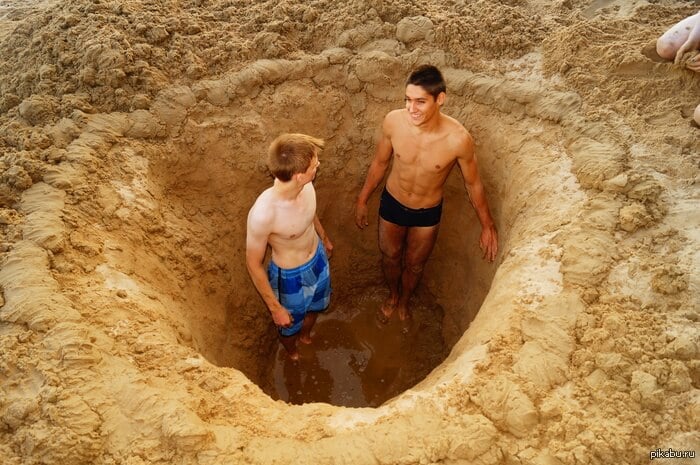It would seem, what danger could threaten a person on the beach, besides the risk of sunstroke? However, in reality it is located right under your feet — this is sand. Of course, in itself it cannot cause any harm to a person, but many people, especially children, love an activity that seems quite harmless at first glance — digging holes on the beach. However, they don’t even realize how dangerous it can be. Some studies suggest that sand kills more people than shark attacks in the water.

More people die from holes on the beach than from shark attacks: Photo source: www.iflscience.com
Here's why you shouldn't dig holes in the sand
One of the tragic cases associated with digging holes occurred in February 2024 – a seven-year-old girl died on a beach in Florida, USA, after she and her brother dug a one and a half meter hole in the sand. At some point, the walls of the pit collapsed on her and buried her alive.
Many people who were nearby rushed to help the girl. In addition, local firefighters arrived on the scene within minutes. However, it was not possible to save the child. The fact is that it is extremely difficult for a person to get out of such pits, if they collapse.

A seven-year-old girl died in a sand pit in the USA. Photo source: www.dailymail.co.uk
People are sometimes afraid of quicksand, which is found near bodies of water, but pits are much more dangerous, but quicksand does not really pose a danger to humans, as we talked about earlier. For example, more than 30 people died in sand pits in the United States alone between 1997 and 2007. Moreover, 87% of them were children and men.
The ages of the victims range from 3 to 21 years. The depth of the sand pits, which became death traps for people, varies from 0.6 to 4.6 meters. Typically, collapse occurs when jumping into a pit, digging tunnels, or even simply when people approach the edge of the pit.
What are the dangers of sand pits and cliffs
Most beaches contain sand, which is a mixture of minerals. They provide the brown or characteristic yellow-orange color. It is usually quite heavy, and the sand grains themselves are smooth, so dry sand can produce a hill with a slope of approximately 33 degrees. This slope is called the “natural slope,” which means the steepest angle at which a mound of sand can remain stable.

The natural slope of the sand pile is about 33 degrees. Photo source: sciencealert.com
Sand is not a type of material, but a grain size, ranging from 0.06 to 2 millimeters in diameter. Moreover, the materials from which it consists determine the type of sand. The most commonly found is quartz sand, which consists of silicon dioxide. Tropical beaches also contain coral sand, which consists of calcium carbonate.
If you try to make the slope steeper, it will not work, as the sand will simply roll off, and in the end the angle will still be 33 degrees. This angle determines the frictional force between each grain of sand. That is, the more strongly the grains of sand can “cling” to each other, the steeper the angle of inclination of the sand hill can be. And this is the main catch.
The fact is that the sand in the pit is usually wet, and therefore more stable. The surface tension between sand grains and water can hold the natural slope even at a 90-degree angle. If you made sand castles as a child, you know how well wet sand holds its shape. However, as it dries, the surface tension begins to weaken. As a result, the natural slope tends to take an angle of 33 degrees. Simply put, the walls of the pit collapse, falling asleep.

Children and teenagers most often die in sand pits. Photo source: pikabu.ru
In addition, a collapse can occur not only due to the sand drying out, but also if a person approaches the edge of the pit. The surface tension between water and grains of sand in this case cannot withstand the load exerted on it.
It should be said that natural sand cliffs, which are often found along the coast, are just as dangerous as sand pits. Perhaps they are even more treacherous, since they have existed for many years and seem unshakable. Often, such cliffs attract the attention of children, but innocent games under them or at the edge of the cliff end in collapse.
Why do people quickly die under the sand
When skiers or climbers get caught in an avalanche, they have a chance to survive, since by putting their hands in a certain way, they can create an air pocket. This will not work with sand – it fills absolutely all the space, and leaves no air for breathing.

Sand cliffs are also extremely dangerous. Photo source: our-crimea.com
It is very difficult to save a person who finds himself in such a trap, as mentioned above, because the sand is heavy and at the same time unstable. While rescuers are scooping sand out of the hole, it continues to collapse under the weight of people and is filled with sand again. A person can remain alive under a sandy rubble for no more than three to five minutes, after which he suffocates.
Be sure to visit our Zen and Telegram channels, here you will find the most interesting news from the world of science and the latest discoveries!
Therefore, experts warn that holes in the sand can be dug no deeper than knee-deep. In addition, you should not go close to sandy cliffs. Moreover, you should not jump from them, try to climb on them or walk along the edge.